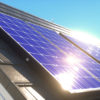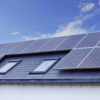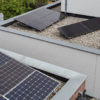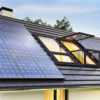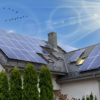With over 400 solar panel companies offering thousands of different products, the solar market in Australia has plenty to offer. While most consumers will use a panel’s make and warranty to understand how good it is, there are many features that shouldn’t be overlooked.
Few energy production technologies have evolved as fast as solar. Today, photovoltaic technology has branched off into many different types, each of which offers specific advantages. Let’s take a bird’s eye view of the solar landscape as it exists today, and what options might be right for you.
How Solar Panels Work
Even though you’ll find solar panels with different designs and configurations, all of them work on the same underlying principle. They convert sunlight into electricity. Note that we’re specifically referring to solar light and not solar heat here.
A solar panel consists of many small solar cells, which are essentially wafers or layers of a photovoltaic substance. The “photovoltaic effect” or the ability of certain materials to generate electricity in the presence of sunlight was first discovered in 1839 by Edmond Becquerel.
Photons in sunlight can trigger an electric field in silicon by displacing electrons in their atoms, which are captured by a conductor, usually a copper wire or plate underneath them. The conductor then transfers the electricity to the inverter where it’s converted into usable AC electricity.
Electricity in silicon cells flows from a “negative” to a “positive” state. The difference between the two states is called the electric potential. A silicon PV cell consists of two layers. The top layer has a negative state (cathode) while the bottom layer has a positive state (anode). When sunlight knocks electrons out of the top layer’s atoms, they are attracted to the bottom layer’s positive potential, creating an electric field.
A Primer on Solar Panel Efficiency
So, we know how solar panels turn light into electricity. Obviously, we’d want all of the light landing on a panel being turned into usable electricity. But, this is quite impossible. The best solar panels in the market have an efficiency rating of around 23%. Although, efforts are on to produce more efficient cells on a cheaper price point.
Three factors can affect a solar panel’s efficiency –
Solar panel material: Most solar panels are made out of monocrystalline silicon, polycrystalline silicon, amorphous silicon, cadmium telluride (CdTe) and copper indium gallium selenide (CIGS). Monocrystalline panels are inherently more efficient than polycrystalline panels. CdTe, a-Si and CIGS panels AKA thin-film solar panels have the lowest efficiency among the three.
Reflectance: Most solar panels come cased in hardened glass. Since glass is reflective, part of the sunlight bounces off it. The lower the reflectivity of a panel, the more sunlight is absorbed by the cells, consequently, the higher the efficiency.
Balance of Systems: The wiring and busing in solar panels that capture the electricity produced by the solar cells also determine your panel’s efficiency.
Do note that a higher efficiency means your solar panels will have a smaller footprint. You may offset the cost by opting for another solar panel instead of paying a premium. Alternatively, if space is an issue or if the installation costs are higher in your area, then high-efficiency panels may make more sense.
Types of Solar Panels
Currently, four types of solar panels are available in the market —
Monocrystalline Solar Panels: These panels are made out of a single crystal of silicon, which is cut into wafers. Because monocrystalline panels are made from pure silicon, the electrons have more space to pass through.
Consequently, these panels have the highest efficiency among all the solar panels available today. They usually offer efficiency upward of 20% in real world conditions. Monocrystalline panels are also the most expensive. Standard cost varies between $1/watt to $1.50/watt.
Monocrystalline panels also come in a variant called Passive Emitter and Rear Cell (PERC) which offer even higher efficiency and you may not know this fact, but PERC was invented in Australia. These panels add a coating beneath the cells which reflects light back to them. PERC panels are about 5% more efficient than monocrystalline cells.
Polycrystalline Solar Panels: Even though monocrystalline panels have higher efficiency, their manufacturing process results in more waste as silicon bars are cut into shape. To overcome this disadvantage, manufacturers melt silicon and mold it into shape. This process results in solar cells with multiple silicon crystals, hence the name polycrystalline.
These panels are cheaper to make and cost between $0.7/watt to $1/watt. However, they offer lower efficiencies than their monocrystalline counterparts because of their denser state. Standard ratings are between 15% and 19% but are improving at a rapid rate.
Thin-film solar panels: These solar panels are made by depositing a photovoltaic substance on a flexible substrate such as plastic, glass or metal. Currently, there are three types of thin-film modules available —
Cadmium telluride (CdTe): CdTe based photovoltaics are the second most common type of solar panels after monocrystalline silicon. CdTe panels were introduced by First Solar, which showed a laboratory peak efficiency of 22.1% and an average real-world efficiency of 16.1%. Average module cost hovers between $0.46/watt – $0.60/watt. While CdTe offers great potential, the toxic nature of cadmium makes disposing these panels a problem.
Amorphous silicon (a-Si): These panels get their name from the shapeless nature of silicon used in them. a-Si panels only require a small fraction of silicon used in other systems, which allows them to have a lower production cost.
a-Si was once heralded as the next step in solar technology, but has since been eclipsed by monocrystalline silicon, CdTe and CIGS based systems. Typical efficiency of a-Si panels range from 6%-8% and costs $0.43/watt-$0.50/watt.
Copper indium gallium selenide (CIGS): CIGS panels use copper, indium, gallium and selenide as their PV medium. The combination has higher absorption than competing technologies, which make the CIGS panel thinner.
Even though CIGS panels have been shown to offer efficiencies upto 22.9% in laboratory conditions, their real world numbers hover between 13% and 15%. CIGS panels are also the most expensive of all the thin-film panels, and typically cost $0.60/watt to $0.70/watt.
Other Factors to Consider Before Buying a Solar Panel
Solar panels have to work in pretty tough conditions. Consequently, they are rigorously tested in laboratory conditions that attempt to simulate real world situations. Even so, there are a few pointers you should be aware of.
Temperature rating: Most solar panels are tested against a temperature of 25 degrees celsius. So, a panel will produce its maximum output as long as the “panel temperature” is 25 degrees or less. We’re highlighting panel temperature here because panels experience greater heat build up than the environment due to metallic components used in them and because of their glass casing, which acts as a greenhouse of sorts.
So, if your area temperature is 25 degrees, your panels can be well over 40 degrees! Temperature is particularly important in Australia since it can get as hot as 35 degrees celsius during the summer months. Monocrystalline and polycrystalline panels have a temperature coefficient between -0.3%/ degree celsius and -0.5%/ degree celsius. Thin film panels fare slightly better with a coefficient of -0.2%/ degree celsius.
So, for every 1 degree celsius rise in temperature, the power output of a mono and polycrystalline panel will fall by 0.3% or 0.5%. Thin film panels will only see an output degradation of 0.2% in similar conditions. This may seem like it means thin film panels are a better option for houses here. But, you should also take into account other factors given below.
Fire rating: Starting in 2013, all solar panels in Australia were required to pass the safety standard IEC 61730-2 which consists of spread of flame test and burning brand test. These tests simulated external fires such as those caused by bushfires.
The spread of flame test exposes the solar panel to a gas flame for four minutes. The burning brand test places a burning object (typically wood) on the panel to see if it will burn through. Since all tier one solar panels are tested against this rating, they can be safely installed on roofs here.
Hail rating: Solar PV modules are encased in hardened glass designed to protect the panel from both heavy wind-load and high-speed impact. The IEC 61215 standard tests solar panels for hail impact. Ice balls measuring 25-45mm in diameter are shot at a speed of 82.8-100.5 kmph on 11 random places on a panel from a height of 51 inches. Both monocrystalline and polycrystalline panels carry a higher hail rating than thin film panels as the former are encased in hardened glass.
Cyclone rating: While there’s no standard rating for cyclones or hurricanes per-se, the IEC 61215 test also requires panels to undergo wind-load tests. A panel must survive under a pressure of 5,400 pascals which is equivalent to sustained wind speeds of 330 kmph. Again, all tier one panels undergo this test so can easily survive even a category 5 cyclone.
That being said, it’s important to note the wind-load test is conducted on the panels and not their mountings. In cyclone conditions, the mounting or the roof itself can collapse under the weight of the panel. So, it’s important to have your roof inspected for faults and load-bearing capacity before installation.
Light-Induced Degradation (LID): All crystalline solar panels undergo a slight performance degradation between 1%-3% as the sunlight reacts with the oxygen in the panels. Higher quality panels exhibit lower LID than those that are made with poorer manufacturing methods.
Conclusion
There really is no right or wrong solar panel design. Any of the panels mentioned above can be a good fit for your requirements, but if you have a choice, always seek out quality. Remember panels should last 25 to 30 years depending on warranty, so an investment in quality pays big long term dividends in delivering ongoing electricity savings. That being said, there are a few guidelines you can use to determine your next solar purchase.
Solar panels need a lot of empty space. Houses in dense, urban areas will have less space for solar panels on their roofs. Monocrystalline or PERC panels can be an ideal solution here. On the other hand, if you live on a farm, a sub-urban area or have a fairly large property, you can opt for less expensive polycrystalline panels instead.
Via the bidmysolar™ Portal you can compare multiple panel types and also compare performance of each with our state of the art solar design technology.

